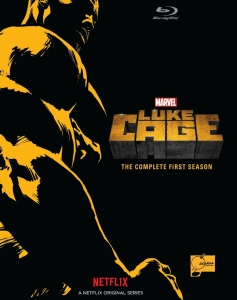For the third time, the Marvel Cinematic Universe gives a starring role to a superpowered New York City vigilante with “Luke Cage” Season 1 (2016, Netflix). Showrunner Cheo Hodari Coker, whose credits include “Almost Human” and the upcoming “Creed II,” brings a slightly different sensibility to the genre by name-dropping bits of Harlem history, music and art and showcasing live music at the club that serves as the main setting.
Criminals and politicians
The overall plot about criminals and politicians – and criminal politicians – making power plays to control Harlem is irksomely similar to “Daredevil” Season 1. It’s a bit frustrating that the bulletproof Luke (Mike Colter), introduced in “Jessica Jones” Season 1, is reticent to take up the mantle of superhero (although, granted, that does make him different from Daredevil and the Punisher). It’s a common superhero trope – even Superman resists the call in “Man of Steel” – but it’s a bit more eye-rolling here because time is measured in episodes of a season rather than minutes of a movie.
The charismatic Colter encourages a viewer to be patient, though, and indeed it’s the performers who make “Luke Cage” Season 1 watchable. The cast is so loaded that “This Is Us” standout Ron Cephas Jones merely has a small role as Bobby Fish, the resident chess player at Pop’s Barber Shop. The shop is the “Switzerland” of Harlem’s constant gang warfare and then a visible symbol of failed peace after it gets shot up.

“Luke Cage” Season 1 (2016)
Netflix, 13 episodes
Creator: Cheo Hodari Coker
Stars: Mike Colter, Simone Missick, Theo Rossi
Among other standouts: Alfre Woodard plays Mariah Dillard, a Hillary Clinton type whose political and criminal connections allow her to stay out of prison. Theo Rossi is sneakily compelling as Shades, who is at the side of all the various kingpins, always managing to survive and even thrive.
Two scary crime lords
First Mahershala Ali as Cottonmouth and then the Tony Todd-esque Erik LaRay Harvey as Diamondback are effectively scary crime lords. Slowly but surely, detective Misty Knight (Simone Missick) becomes a cop worth rooting for, and nurse Claire (Rosario Dawson) – a Netflix MCU veteran – grows into a cute love interest for Luke.
The writing is clunkier than in “Daredevil” and “Jessica Jones,” and indeed the “Luke Cage” comic book was created in the 1970s, the product of white comic-book writers churning out a black superhero to tap into that demographic. Cage’s catchphrases – “sweet Christmas” and “sweet sister” – are those writers’ attempts to sound “black.”
While the TV show acknowledges those ’70s roots with its theme song and soundtrack choices, it’s unfortunate that another old-school element is the obviously scripted nature of the plot. That said, Coker makes “Luke Cage” relevant for the modern era by exploring police violence and the inner-city drug and gun trades.

Here are my rankings of the 13 episodes:
1. “You Know My Steez” (episode 13, written by Aïda Mashaka Croal and Cheo Hodari Coker)
I’m not sure it was fair to make us wait this long for flashbacks of Luke and Diamondback as Savannah, Ga., youths who learned to box together, but the episode itself gets high marks. It opens with a “Rocky V” homage of the half-brothers fighting (Diamondback has a Hammer Industries power suit that evens the playing field) in the street as people react to every blow.
The stunt team is on their game here, with the rivals breaking through walls and smashing into vehicles, and the camera crew makes the steamy streets look great. There’s a bit of delayed satisfaction, though, since Mariah Dillard slithers away from the law yet again and the feds take Luke back to Seagate Prison. As such, he’s not able to learn if “the Cuban blend is particularly robust” – a reference to relations with Claire that had me laughing out loud.
2. “Step in the Arena” (4, Charles Murray)
After a slow start to the series, now we’re getting somewhere. This flashback episode at Seagate Prison – off the coast of Savannah — shows that Luke got his powers in a way reminiscent of Wolverine, except as an accident. This hour reminds me of those episodes of “The X-Files” (which gets name-dropped) about experiments on prisoners. The underground fight ring is a cliché, but on the plus side, Luke has sparkling chemistry with Reva (Parisa Fitz-Henley), who we know from “Jessica Jones” later becomes Luke’s wife.
3. “Soliloquy of Chaos” (11, Akela Cooper and Murray)
This episode is satisfying despite being heavy-handed. Method Man delivers a radio rap ode to Luke Cage, and citizens wear hoodies with holes in them as a sign of solidarity. It’s refreshing that most people believe Luke is innocent of what he’s been blamed for. Luke sticking a bad guy in a Dumpster and crumpling it up is delightful, and Shades solidifies himself as a villain we grudgingly root for when he escapes Diamondback’s assassination attempt.
4. “Just to Get a Rep” (5, Jason Horwitch)
In order to make back the money Cage had nabbed from him, Cottonmouth simply extorts more from the citizenry via his protection ring. It seems like he might be overplaying his hand, but he gets away with it – for now. Still, this is a key episode where everything gets ratcheted up. Luke and Cottonmouth give dueling speeches at Pop’s funeral, and the conflict moves firmly into the public eye.
5. “DWYCK” (9, Christian Taylor)
In this decompressed yet satisfying episode, Diamondback puts forced-consumption economics in a nutshell with “You buy or you die,” and drags Dillard in further just when she tries to get out. (As is always the case with these things, you can never get out.)
We learn more about Misty in her psych evaluation: The murder of her childhood friend instilled in her a thirst for justice. And Luke and Claire track down the Seagate doctor in Georgia for help with removing a Hammer Industries-designed “Judas bullet” from Luke’s body. So we get into the weeds of the science behind his near-invulnerable skin, which is based on abalone cells.
6. “Who’s Gonna Take the Weight?” (3, Matt Owens)
In a standout action sequence, Cage goes reverse-“Terminator” and plows through Cottonmouth’s stronghold, letting an insane amount of bullets bounce off him. Misty’s partner Scarfe (Frank Whaley) turning out to be corrupt is a nice twist, since I had enjoyed their chemistry. An example is when they are debating the merits of the two sides in “Captain America: Civil War,” just as many fans were doing around this time.
7. “Take It Personal” (10, Horwitch)
I understand that the whole season is about how politicians can fool populaces, but it strikes me as unlikely that people cheer for Mariah’s rebuke of police violence and seconds later cheer for her proposal to beef up police armament. I know many people’s political views are hypocritical, but damn. The imagery of Luke writhing in the vat of boiling acid is striking (I wonder if it comes from the comics), but the revelation – via Seagate digital files – that Reva was using him hurts him more. Many people can relate to his realization that he misses the idea of Reva, not the actual person.
8. “Moment of Truth” (1, Coker)
Off the bat, we see that Harlem is a scarier place than Hell’s Kitchen, but also less mysterious. We’re shown right away that city councilwoman Dillard and drugs- and weapons-runner Cottonmouth are openly in cahoots; in fact, they are cousins. When a thug’s fist breaks when smashing against Cage’s face in slo-mo, it’s a sign that the action will be better than on “Jessica Jones,” but it’s also frustrating that we don’t know why Luke is lying low, holding down a cash job as a floor sweeper at Pop’s.
9. “Manifest” (7, Cooper)
We learn that the late Mama Mabel (one of Harlem’s founding crime lords) shaped both Cottonmouth and Mariah, which raises the intriguing possibility that since their evil is taught rather than ingrained, there’s some good in them. When Mariah kills Cottonmouth, though, that ends that. It’s interesting to note that Mama Mabel didn’t want any part of the drug trade, whereas any other type of crime was on the table, but that remains nothing more than a trivial tidbit.
10. “Code of the Streets” (2, Coker)
Here we see that violence is more front-and-center in “Luke Cage” than in the Hell’s Kitchen shows or even “Atlanta.” The barbershop’s status as “Switzerland” falls apart thanks to one trigger-happy baddie, and Luke’s long day appropriately ends with him being randomly held up at gunpoint by a young man.
11. “Now You’re Mine” (11, Taylor)
This is a standard hostage episode, and it ends in irksome fashion when the police – obsessed with nabbing Luke — let Diamondback waltz out a back door of the club. The episode delivers a smart but tossed-off commentary on the police being armed with Judas bullets, with Misty’s boss saying she hopes they’ll never have to use them and that the bullets won’t end up in criminal hands — even though she has seen enough to know both of those things will probably come to pass.
12. “Blowin’ Up the Spot” (8, Croal)
This is a frustrating episode: Luke and the newly arrived Diamondback clash for the first time, but we don’t know their history yet. Misty briefly is convinced Luke is innocent of killing Cottonmouth, but then the frame-job gets more elaborate and she shifts gears.
13. “Suckas Need Bodyguards” (6, Nathan Louis Jackson)
This hour is a big tease. The local TV station has built a case against Dillard entirely off-screen, and Scarfe’s notebook seems like it will put away Cottonmouth. Yet Dillard and Cottonmouth remain untouched by the law. And “Trish Talk” radio callers are undecided about vigilantism. Really? Since this debate had recently played out in a nearby neighborhood, it seems like Daredevil and the Punisher should at least be referenced by someone.
How would you rate the 13 episodes of “Luke Cage” Season 1? Share your lists below.

